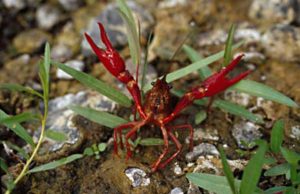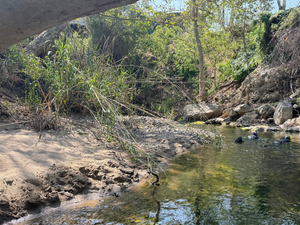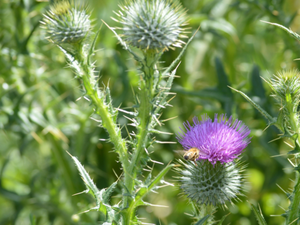Invasive Species of the Santa Monica Mountains
New Zealand Mudsnails
 New Zealand Mudsnails can be as small as a grain of sand or up to 1/8 inch. They are typically brown or black.
New Zealand Mudsnails can be as small as a grain of sand or up to 1/8 inch. They are typically brown or black.
WARNING! New Zealand Mudsnails Threaten Native Wildlife
The water that runs through Topanga Creek is the lifeline which fuels the whole ecosystem of our home town, and we are incredibly lucky because it houses so many beautiful native creatures, such as the endangered Southern Steelhead Trout, Arroyo Chub, Western Pond Turtles, Pacific Tree Frog, California Newt, Arboreal Salamander, Western Toad and more. A large part of why this is possible is that we have fewer invasive species living here than have moved into adjacent watersheds throughout Southern California. Unfortunately, after keeping them at bay for nearly 10 years after they were found in nearby waterbodies, the presence of New Zealand Mudsnails in Topanga Creek was confirmed during the summer of 2016. At this time they appear to be blooming in only one segment of the creek about halfway between the bridge and the ocean.
These snails are so tiny that it is very difficult to see them on the soles of boots, on wetsuits or in the cracks in a bicycle tire tread. One snail can reproduce asexually, rapidly infecting a pristine watershed.
What does this mean for the community of Topanga?
We need to take care when we are hiking, swimming, riding, biking and working in the Santa Monica Mountains. When feasible, stay off creek banks and creeks. Do not go from one watershed to the next in one day.
After visiting creeks, go home and remove and scrub all your gear. Dry everything completely for 48 hours. If possible, put any gear that had direct contact with the substrate of the creek in a freezer for a minimum of 4 hours. Otherwise, put clothes, bathing suits and wetsuits in the dryer. Freezing, hot water, or drying treatments are recommended over chemical treatments because they are usually less expensive, more environmentally sound, and possibly less destructive to gear. However, most physical methods require longer treatment times and often cannot be performed in the field.
Keep Topanga beautiful, be sure you are clean of snails before you play in the creek.
Red Swamp Crayfish
 Have you seen this creature in your local streams and ponds? The red swamp crayfish (Procambarus clarki) is a predator and scavenger with potentially devastating impacts on native amphibian, fish, and invertebrate populations. Like many introduced animals, the red swamp crayfish has no local predators to keep them in check, allowing them to proliferate. Recent studies conducted in the Santa Monica Mountains have linked crayfish to the decline of some of our local amphibians such as the California coastal range newt. Once introduced into our aquatic habitats, red swamp crayfish are very difficult to eradicate. Crayfish are able to burrow down three feet into the mud when water levels are low and are capable of moving on land to find nearby pools. Crayfish are excellent parents, caring for the eggs and young until they have grown to a sufficient size to venture out on their own. It takes less than one year for a crayfish to reach full reproductive maturity. How do these lobster-like creatures make it into our lakes and streams? Unfortunately, we introduce them. Crayfish are popular bait for bass fishermen. They are sold in many fish and tackle shops and are stocked in local lakes as a food source for game fish like large mouth bass and bluegill. However, the problem is not just the local fisherman. The way we live also provides habitat for these creatures. A naturally dry creek is not ideal habitat for a crayfish. By over-watering our lawns and hosing down our streets, we provide the excess flows that crayfish need to survive. Do you have water flowing through your nearby creeks? If you do, crayfish may already be there. Crayfish can be so prolific that you may find fifty of them sitting at the bottom of a deep pool.
Have you seen this creature in your local streams and ponds? The red swamp crayfish (Procambarus clarki) is a predator and scavenger with potentially devastating impacts on native amphibian, fish, and invertebrate populations. Like many introduced animals, the red swamp crayfish has no local predators to keep them in check, allowing them to proliferate. Recent studies conducted in the Santa Monica Mountains have linked crayfish to the decline of some of our local amphibians such as the California coastal range newt. Once introduced into our aquatic habitats, red swamp crayfish are very difficult to eradicate. Crayfish are able to burrow down three feet into the mud when water levels are low and are capable of moving on land to find nearby pools. Crayfish are excellent parents, caring for the eggs and young until they have grown to a sufficient size to venture out on their own. It takes less than one year for a crayfish to reach full reproductive maturity. How do these lobster-like creatures make it into our lakes and streams? Unfortunately, we introduce them. Crayfish are popular bait for bass fishermen. They are sold in many fish and tackle shops and are stocked in local lakes as a food source for game fish like large mouth bass and bluegill. However, the problem is not just the local fisherman. The way we live also provides habitat for these creatures. A naturally dry creek is not ideal habitat for a crayfish. By over-watering our lawns and hosing down our streets, we provide the excess flows that crayfish need to survive. Do you have water flowing through your nearby creeks? If you do, crayfish may already be there. Crayfish can be so prolific that you may find fifty of them sitting at the bottom of a deep pool.  The invasive crayfish is just one example of our potential impact on local creeks and streams. Introducing anything into an environment that does not belong there, including pet goldfish and turtles, excess water, pesticides and fertilizers, effects the local plant and animal species that live there.
The invasive crayfish is just one example of our potential impact on local creeks and streams. Introducing anything into an environment that does not belong there, including pet goldfish and turtles, excess water, pesticides and fertilizers, effects the local plant and animal species that live there.
Arundo donax
Arundo donax, or Giant reed/Spanish reed, is a large and fast-growing grass that grows plentifully across riparian habitats throughout the Santa Monica Mountains. It’s thought to be native to eastern Asia and was introduced to this area when homeowners planted it as a “natural” property barrier around their homes, using it as an alternative for wooden or chainlink fences. It may also have been planted along hillsides for erosion control.

Arundo donax in Topanga Creek
Unfortunately it has since invaded natural landscapes, pushed out native riparian vegetation, sucked up dwindling freshwater resources, spread wildly through stream corridors and contributed to higher fire risk as it will burn readily.
Different organizations are attempting to eradicate arundo including CA State Parks, National Parks Service, TreePeople Land Trust and the Coastal Conservancy.
Italian & Sow Thistle
Italian and sow thistle are particularly pesky and painful invasives that sprout throughout Topanga State Park during spring. Their pokey spines and thorns make them difficult to remove but our fearless team of field biologists bravely trek into their thorny underbrush and yank them out of the ground year after year to ensure previously planted young native oak trees can continue to thrive. If left to their own devices these pointed weeds would readily steal the freshwater volunteers kindly provide our growing baby oaks during spring volunteer events.

Sow thistle
The thistle likely began initial invasion with the arrival of Spanish colonists. Over the spring season they can grow as tall as three or four feet.
